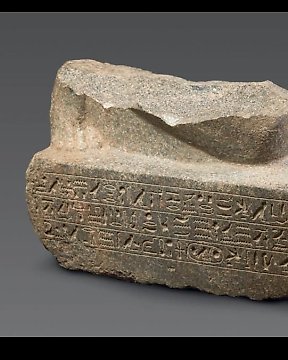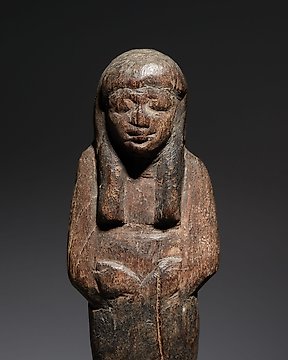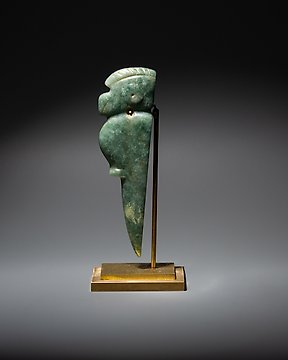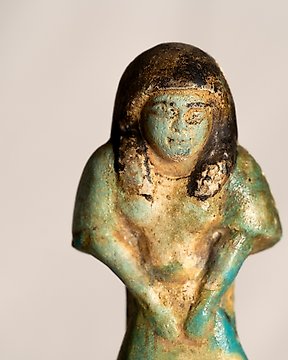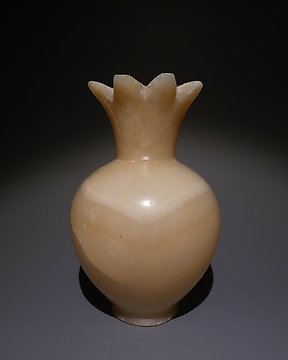Magnifique témoin du passé, envoyé avec tous les justificatifs, impeccable. Encore une fois très satisfait, un grand merci
Προβολή μετάφρασηςΑρχαία Αιγυπτιακή Ξύλο Στρογγυλή στήλη για το Padiminty, περίοδος Saite, 26η Δυναστεία, 664 - 525 B.C. 39,5 εκ. Υψ. Τέλεια
Αρ. 84870819



Round-Top Stele for Padiminty
- Top Quality -
- Nice polychrome -
Ancient Egypt, Saite period, 26th Dynasty, 664 - 525 B.C.
Wood, stucco and pigments.
Height 39.5 cm, width 40 cm and thickness 4.5 cm.
CONDITION: Good state of conservation, it presents a lack in the lower left area of the polychromy.
PROVENANCE: - Private collection, Paris, France. Formed at the beginning of the 20th century.
DOCUMENTATION: - Attached is a study on the antiquity of the piece issued by an Egyptologist.
PARALLELS: Fig. 1 Stela of Ra-Horakhty and Atum. Ancient Egypt, Late Period, 662 – 525 B.C., 35.5 cm high. Wood, stucco and pigments. Penn Museum, Philadelphia. Inv. 8859.
DESCRIPTION:
Funerary stele carved from a single block of wood, probably a Lebanese scepter, with a circular upper part. This typology is called a round-top stele. It presents a layer of stucco on which the entire surface has been pigmented with a decoration made up of registers, both figurative and textual, framed by a row of baguettes, blue, green and red boxes, interspersed with black and white stripes, running throughout the profile.
The wings of the falcon god Horus, crowning the circular area as a stylistic resource, protect the ascension of the rising sun (Ra), Khepry, as well as the texts that, with their opposing reading meanings, refer to his ascension, drawn in red profile on a white background. Said record is translated: "The one from Beedet" (the Horus of Edfu), god grade, the one with the colored wings (variegated in literal translation), the one who appears (comes out) on the horizon (like Khepry)". United by the hieroglyphic centrla, "the eastern horizon of the sky", the place of sunrise, being closely related to the ascent of the beetle, serves as a link between the two identical texts.
Between the curved upper part and the two figured squares, two rows of baguettes seem to wrap a horizontal alignment of khekeru. This last ornament (as this is its name in ancient Egyptian) is reminiscent of pre-dynastic times, when the Egyptians lived in huts made of reeds and palms. The upper finishes of these huts were a continuous and horizontal termination of the coronations of the palm leaves with a purely decorative character. In fact, its presence on the stela indicates that it has been given a sanctuary character, a much more detailed character in other types of stelae.
In the center, a vertical register separating both scenes says: "Offering made by the king to Osiris, Lord of Busiris, great god, Lord of heaven, superior god among gods." The "offering given by the king" is a protocol phase, but obligatory in Egyptian texts of this type. Everything was done through the king, as the only mediator between gods and men.
Like the upper register, both paintings present the scene on a blue background, and red or ocher for the outlines of figures and text on a white background or interior. The painting on the left shows the owner of the stela in a position of adoration, his arms outstretched towards the god Osiris, the dead man dressed in a long and wide pleated white linen dress. He wears a wsekh (the “wide”) necklace as his only jewel, as he wears no bracelets on his wrists or anklets. On the short wig that he seems to be wearing, since a ribbon holds it back like a diadem, there is a Theban party cone. In front of the offerer, a huge blue water lily flower is placed on an offering table and next to it is a large glass of ointment. All offered to the god of the dead, Osiris. The god, who is seated in an armchair, holds the symbols of his royal authority: the heka scepter and the disputed nekhakha (ancient whip or fly-swatter?). On his head, the atef crown.
The painting on the right follows the same compositional scheme but now the homage is in front of the god Ra, represented in his falcon form touched with the solar disk. The disappeared person is dressed identically to the person in the painting on the left, so it must be deduced that it is most certainly the same person, the owner of the stela. Nor has a distinction been sought between the clothing of the two gods: both are treated with the same finish: the shroud of Osiris and the outfit of Ra. The small writing records are not legible, although by comparison they allude to the name of the deceased, titles and names of the represented god.
Next, a last separation by baguettes shows four horizontal registers of hieroglyphic writing: “(…) the Osiris Padiminty (…) fair of voice. His mother is the lady of the house (...) and Oh Ra! Luminous Lord (when) you ascend on the horizon. You light up the sky and the Two Lands (Egypt). This god, Padiminty fair-voiced, adore the brilliance of him every day (…) Padiminty, justified with (before) this god, the Lord of heaven, at his arrival in port (…) ”. This is where the stele's owner, Padiminty, is named.
Then a vertical register separates five horizontal ones on each side emulating the two upper figurative scenes. The central text says: "The Osiris Padiminty fair of voice", that is, the deceased has accessed the Hereafter and therefore was reborn in the kingdom of Osiris.
The five registers: "I greet you (...) duat (the 'Beyond (...)", "I greet you, domain (territory) of the gods (...) father (...)", "I greet you (... ) all these enemies (...)", "I salute you (...) the great headquarters". Possibly it is a reference to the royal Theban necropolis. "... the gods greet you (welcome) when you ascend on the horizon (...) ” and “I salute you (…) Lord of heaven. , in fact, it is divided into two halves. These two sections start from the center of the stela at the top and their readings have a divergent character. Each part of the record begins with an ankh sign ("life"), opposite to that of the other part.
Left side: "Life. Offering given by the king to Osiris who presides over the West. Great God, Lord of Abydos, so that he grants all good and pure things, all good things of the offering ( …) for the Osiris, Pa diminty, fair of voice, son of Padiamón (fair of voice)”. Padimon is the name of the father. The right side: “Life. Offering that the king gives to Osiris (...) Geb, heir of the gods, so that they grant the propitiatory prayer of bread, beer, cattle, poultry, incense, ointments and wine for the Osiris (Padiminty)”.
The most significant aspect of this piece is the arbitrary and unusual distribution of the registers in which the texts are inscribed. Two vertical registers are used to separate, in the upper part, two figurative paintings, and in the lower part, two groups of five independent horizontal registers, that is to say that there is no continuity of a text on the other side of the vertical register. Finally, a horizontal lower closing register, wider than the rest of the registers, in which, originally, the name of the deceased appeared at the end of it (left side), but unfortunately it has been lost due to breakage and detachment of the stucco support.
Notes:
- The piece includes authenticity certificate.
- The piece includes Spanish Export License.
- The seller guarantees that he acquired this piece according to all national and international laws related to the ownership of cultural property. Provenance statement seen by Catawiki.
#MorganNiquetCollection
Ιστορία πωλητή
Round-Top Stele for Padiminty
- Top Quality -
- Nice polychrome -
Ancient Egypt, Saite period, 26th Dynasty, 664 - 525 B.C.
Wood, stucco and pigments.
Height 39.5 cm, width 40 cm and thickness 4.5 cm.
CONDITION: Good state of conservation, it presents a lack in the lower left area of the polychromy.
PROVENANCE: - Private collection, Paris, France. Formed at the beginning of the 20th century.
DOCUMENTATION: - Attached is a study on the antiquity of the piece issued by an Egyptologist.
PARALLELS: Fig. 1 Stela of Ra-Horakhty and Atum. Ancient Egypt, Late Period, 662 – 525 B.C., 35.5 cm high. Wood, stucco and pigments. Penn Museum, Philadelphia. Inv. 8859.
DESCRIPTION:
Funerary stele carved from a single block of wood, probably a Lebanese scepter, with a circular upper part. This typology is called a round-top stele. It presents a layer of stucco on which the entire surface has been pigmented with a decoration made up of registers, both figurative and textual, framed by a row of baguettes, blue, green and red boxes, interspersed with black and white stripes, running throughout the profile.
The wings of the falcon god Horus, crowning the circular area as a stylistic resource, protect the ascension of the rising sun (Ra), Khepry, as well as the texts that, with their opposing reading meanings, refer to his ascension, drawn in red profile on a white background. Said record is translated: "The one from Beedet" (the Horus of Edfu), god grade, the one with the colored wings (variegated in literal translation), the one who appears (comes out) on the horizon (like Khepry)". United by the hieroglyphic centrla, "the eastern horizon of the sky", the place of sunrise, being closely related to the ascent of the beetle, serves as a link between the two identical texts.
Between the curved upper part and the two figured squares, two rows of baguettes seem to wrap a horizontal alignment of khekeru. This last ornament (as this is its name in ancient Egyptian) is reminiscent of pre-dynastic times, when the Egyptians lived in huts made of reeds and palms. The upper finishes of these huts were a continuous and horizontal termination of the coronations of the palm leaves with a purely decorative character. In fact, its presence on the stela indicates that it has been given a sanctuary character, a much more detailed character in other types of stelae.
In the center, a vertical register separating both scenes says: "Offering made by the king to Osiris, Lord of Busiris, great god, Lord of heaven, superior god among gods." The "offering given by the king" is a protocol phase, but obligatory in Egyptian texts of this type. Everything was done through the king, as the only mediator between gods and men.
Like the upper register, both paintings present the scene on a blue background, and red or ocher for the outlines of figures and text on a white background or interior. The painting on the left shows the owner of the stela in a position of adoration, his arms outstretched towards the god Osiris, the dead man dressed in a long and wide pleated white linen dress. He wears a wsekh (the “wide”) necklace as his only jewel, as he wears no bracelets on his wrists or anklets. On the short wig that he seems to be wearing, since a ribbon holds it back like a diadem, there is a Theban party cone. In front of the offerer, a huge blue water lily flower is placed on an offering table and next to it is a large glass of ointment. All offered to the god of the dead, Osiris. The god, who is seated in an armchair, holds the symbols of his royal authority: the heka scepter and the disputed nekhakha (ancient whip or fly-swatter?). On his head, the atef crown.
The painting on the right follows the same compositional scheme but now the homage is in front of the god Ra, represented in his falcon form touched with the solar disk. The disappeared person is dressed identically to the person in the painting on the left, so it must be deduced that it is most certainly the same person, the owner of the stela. Nor has a distinction been sought between the clothing of the two gods: both are treated with the same finish: the shroud of Osiris and the outfit of Ra. The small writing records are not legible, although by comparison they allude to the name of the deceased, titles and names of the represented god.
Next, a last separation by baguettes shows four horizontal registers of hieroglyphic writing: “(…) the Osiris Padiminty (…) fair of voice. His mother is the lady of the house (...) and Oh Ra! Luminous Lord (when) you ascend on the horizon. You light up the sky and the Two Lands (Egypt). This god, Padiminty fair-voiced, adore the brilliance of him every day (…) Padiminty, justified with (before) this god, the Lord of heaven, at his arrival in port (…) ”. This is where the stele's owner, Padiminty, is named.
Then a vertical register separates five horizontal ones on each side emulating the two upper figurative scenes. The central text says: "The Osiris Padiminty fair of voice", that is, the deceased has accessed the Hereafter and therefore was reborn in the kingdom of Osiris.
The five registers: "I greet you (...) duat (the 'Beyond (...)", "I greet you, domain (territory) of the gods (...) father (...)", "I greet you (... ) all these enemies (...)", "I salute you (...) the great headquarters". Possibly it is a reference to the royal Theban necropolis. "... the gods greet you (welcome) when you ascend on the horizon (...) ” and “I salute you (…) Lord of heaven. , in fact, it is divided into two halves. These two sections start from the center of the stela at the top and their readings have a divergent character. Each part of the record begins with an ankh sign ("life"), opposite to that of the other part.
Left side: "Life. Offering given by the king to Osiris who presides over the West. Great God, Lord of Abydos, so that he grants all good and pure things, all good things of the offering ( …) for the Osiris, Pa diminty, fair of voice, son of Padiamón (fair of voice)”. Padimon is the name of the father. The right side: “Life. Offering that the king gives to Osiris (...) Geb, heir of the gods, so that they grant the propitiatory prayer of bread, beer, cattle, poultry, incense, ointments and wine for the Osiris (Padiminty)”.
The most significant aspect of this piece is the arbitrary and unusual distribution of the registers in which the texts are inscribed. Two vertical registers are used to separate, in the upper part, two figurative paintings, and in the lower part, two groups of five independent horizontal registers, that is to say that there is no continuity of a text on the other side of the vertical register. Finally, a horizontal lower closing register, wider than the rest of the registers, in which, originally, the name of the deceased appeared at the end of it (left side), but unfortunately it has been lost due to breakage and detachment of the stucco support.
Notes:
- The piece includes authenticity certificate.
- The piece includes Spanish Export License.
- The seller guarantees that he acquired this piece according to all national and international laws related to the ownership of cultural property. Provenance statement seen by Catawiki.
#MorganNiquetCollection
Ιστορία πωλητή
- 747
- 6
- 0
Thank you for the Special offer and the fast shipping of this excellent piece of art!
Προβολή μετάφρασηςvery good description of the object, very good price for this rare item,. Fast sending (has been at my place 2 days after buying!). Definitely would buy again.
Προβολή μετάφρασηςSehr schön
Προβολή μετάφρασηςAs described, perfect logistic
Προβολή μετάφρασηςgreat seller, everything came as should with certificate of authenticity
Προβολή μετάφρασηςExceptionally well packaged, description aligned with positing received
Προβολή μετάφρασηςReally precious, but without sound...
Προβολή μετάφρασηςPainting well packed and rapidly sent!
Προβολή μετάφρασηςsempre grande rapidità e professionalità
Προβολή μετάφρασηςparfait bien reçu, merci
Προβολή μετάφρασηςVery satisfied with the small Greek Lekythos. As always (we have already bought several items from Bagot), the object was wrapped and sent immediately and with the greatest care.
Προβολή μετάφρασηςPerfect, excellent condition, good packaging, the parcel arrived without any problems… all is perfect as usual. Thank you very much and wait for an other nice piece like this one. Gilles.
Προβολή μετάφρασης+++ Top vendeur professionnel comme d'habitude
Προβολή μετάφρασηςEmbora o custo de transporte esteja acima da média foi, realmente, muito bem executado e em embalagem cuidada. Expeditos e profissionais. Recomendo
Προβολή μετάφρασηςSnel en correct en goed verpakt verzonden
Προβολή μετάφρασηςoggetto bellissimo, fedele alla descrizione, venditore affidabile
Προβολή μετάφρασηςVery nice piece and fast delivery
Προβολή μετάφρασηςEverything ok, top seller! Thank you again!
Προβολή μετάφρασηςvery beautiful and fast shipping!thank you!
Προβολή μετάφρασηςExcelent, very good piece++++
Προβολή μετάφρασηςVendedor increíble muy buenos he comprado muchas veces todo perfecto. Muchas gracias
Προβολή μετάφρασηςpas de problème ; merci beaucoup
Προβολή μετάφρασηςtres rapide conforme hope next +++
Προβολή μετάφρασηςSehr schön! Vielen Dank!
Προβολή μετάφρασης- 747
- 6
- 0
Magnifique témoin du passé, envoyé avec tous les justificatifs, impeccable. Encore une fois très satisfait, un grand merci
Προβολή μετάφρασηςΑποποίηση ευθυνών
Ο πωλητής εγγυάται και μπορεί να αποδείξει ότι το αντικείμενο αποκτήθηκε νόμιμα. Ο πωλητής ενημερώθηκε από την Catawiki ότι έπρεπε να παράσχει τα δικαιολογητικά που απαιτούνται από τους νόμους και τους κανονισμούς στη χώρα διαμονής τους. Ο πωλητής εγγυάται και δικαιούται να πουλήσει/εξάγει αυτό το αντικείμενο. Ο πωλητής θα παρέχει στον αγοραστή όλες τις πληροφορίες προέλευσης που είναι γνωστές για το αντικείμενο. Ο πωλητής διασφαλίζει ότι οποιεσδήποτε απαραίτητες άδειες έχουν ήδη κανονιστεί /θα κανονιστεί. Ο πωλητής θα ενημερώσει αμέσως τον αγοραστή για τυχόν καθυστερήσεις στην απόκτηση τέτοιων αδειών.
Ο πωλητής εγγυάται και μπορεί να αποδείξει ότι το αντικείμενο αποκτήθηκε νόμιμα. Ο πωλητής ενημερώθηκε από την Catawiki ότι έπρεπε να παράσχει τα δικαιολογητικά που απαιτούνται από τους νόμους και τους κανονισμούς στη χώρα διαμονής τους. Ο πωλητής εγγυάται και δικαιούται να πουλήσει/εξάγει αυτό το αντικείμενο. Ο πωλητής θα παρέχει στον αγοραστή όλες τις πληροφορίες προέλευσης που είναι γνωστές για το αντικείμενο. Ο πωλητής διασφαλίζει ότι οποιεσδήποτε απαραίτητες άδειες έχουν ήδη κανονιστεί /θα κανονιστεί. Ο πωλητής θα ενημερώσει αμέσως τον αγοραστή για τυχόν καθυστερήσεις στην απόκτηση τέτοιων αδειών.

